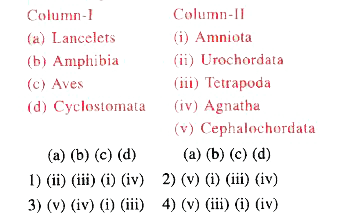Match column I with column II and select the correct option from the given codes.
ColumnIColumnIIA.Ladybird beetles feeding on insects(i)MutualismB.Barnacles growing on the back of a whale(ii)PredationC.Wasp pollinating the fig infloresence(iii)CompetitionD.Lice living on skin of humans(iv)Commensalism(v)Parasitism
A−(iii),B−(iv),C−(i),D−(v)
A−(iv),B−(iii),C−(iv),D−(i)
A−(ii),B−(i),C−(v),D−(iv)
A−(iii),B−(ii),C−(i),D−(iv)
The correct Answer is:A
To solve the problem of matching Column I with Column II, we need to analyze each item in Column I and determine the type of interaction it represents from Column II. Here's the step-by-step breakdown:
Step 1: Analyze "Ladybird beetles feeding on insects"
- Type of Interaction: This describes a situation where one organism (the ladybird beetle) feeds on another organism (insects).
- Conclusion: This is an example of Predation, where the predator benefits by obtaining food, while the prey is harmed.
- Match: A → (ii) Predation
Step 2: Analyze "Barnacles growing on the back of a whale"
- Type of Interaction: In this case, barnacles attach themselves to a whale. The whale is not harmed, but the barnacles benefit from mobility and access to food.
- Conclusion: This is an example of Commensalism, where one species benefits and the other is neither helped nor harmed.
- Match: B → (iv) Commensalism
Step 3: Analyze "Wasp pollinating the fig inflorescence"
- Type of Interaction: The wasp pollinates the fig and, in return, receives nectar and a place to lay its eggs. Both the wasp and the fig benefit from this interaction.
- Conclusion: This is an example of Mutualism, where both species benefit from the interaction.
- Match: C → (i) Mutualism
Step 4: Analyze "Lice living on skin of humans"
- Type of Interaction: Lice feed on human blood, deriving nutrition while harming the host.
- Conclusion: This is an example of Parasitism, where the parasite benefits at the expense of the host.
- Match: D → (v) Parasitism
Final Matching Summary:
- A → (ii) Predation
- B → (iv) Commensalism
- C → (i) Mutualism
- D → (v) Parasitism
Conclusion:
The correct matches are:
- A - (ii)
- B - (iv)
- C - (i)
- D - (v)
Thus, the correct answer is option A.
---
- Type of Interaction: This describes a situation where one organism (the ladybird beetle) feeds on another organism (insects).
- Conclusion: This is an example of Predation, where the predator benefits by obtaining food, while the prey is harmed.
- Match: A → (ii) Predation
- Type of Interaction: In this case, barnacles attach themselves to a whale. The whale is not harmed, but the barnacles benefit from mobility and access to food.
- Conclusion: This is an example of Commensalism, where one species benefits and the other is neither helped nor harmed.
- Match: B → (iv) Commensalism
- Type of Interaction: The wasp pollinates the fig and, in return, receives nectar and a place to lay its eggs. Both the wasp and the fig benefit from this interaction.
- Conclusion: This is an example of Mutualism, where both species benefit from the interaction.
- Match: C → (i) Mutualism
- Type of Interaction: Lice feed on human blood, deriving nutrition while harming the host.
- Conclusion: This is an example of Parasitism, where the parasite benefits at the expense of the host.
- Match: D → (v) Parasitism
- A → (ii) Predation
- B → (iv) Commensalism
- C → (i) Mutualism
- D → (v) Parasitism
The correct matches are:
- A - (ii)
- B - (iv)
- C - (i)
- D - (v)
Topper's Solved these Questions
- ORGANISMS AND POPULATIONBOOK - NCERT FINGERTPS ENGLISHCHAPTER - ORGANISMS AND POPULATIONEXERCISE - HOTS
5 Videos
- ORGANISMS AND POPULATIONBOOK - NCERT FINGERTPS ENGLISHCHAPTER - ORGANISMS AND POPULATIONEXERCISE - NCERT
20 Videos
- MOLECULAR BASIS OF INHERITANCEBOOK - NCERT FINGERTPS ENGLISHCHAPTER - MOLECULAR BASIS OF INHERITANCEEXERCISE - Molecular Basis Of Inheritance
151 Videos
- PRACTICE PAPERSBOOK - NCERT FINGERTPS ENGLISHCHAPTER - PRACTICE PAPERSEXERCISE - Practice paper
150 Videos
Similar Questions
Match column I with column II and select the correct option from the given codes.
Column IColumn IIA. Salivary amylase(i)ProteinsB. Bile salts(ii)Milk proteinsC. Rennin(iii)StarchD. Pepsin(iv)Lipids
View SolutionMatch column I with column II and select the correct option from the gives codes.
ColumnIColumnIIA.Wings(i)ReptilesB.Operculum(ii)ChondrichthyesC.Scutes(iii)BirdsD.Cartilaginous endoskeletion(iv)Osteichthyes
View Solution
Knowledge Check
Match column I with II column II and select the correct option from the given codes .
 AA-(ii), B-(iii), C-(iv), D-(i)BA-(iii), B-(ii), C-(i), D-(iv)CA-(iii), B-(ii), C-(iv), D-(i)DA-(i), B-(ii), C-(iii), D-(iv)
AA-(ii), B-(iii), C-(iv), D-(i)BA-(iii), B-(ii), C-(i), D-(iv)CA-(iii), B-(ii), C-(iv), D-(i)DA-(i), B-(ii), C-(iii), D-(iv)Mathc column I with column II and select the correct option from the given codes.
 AA-(ii), B-(iii), C-(iv), D-(i), E-(v)BA-(v), B-(iv), C-(iii), D-(i), E-(ii)CA-(i), B-(iii), C-(iv), D-(ii), E-(v)DA-(i), B-(iv), C-(iii), D-(ii), E-(v)
AA-(ii), B-(iii), C-(iv), D-(i), E-(v)BA-(v), B-(iv), C-(iii), D-(i), E-(ii)CA-(i), B-(iii), C-(iv), D-(ii), E-(v)DA-(i), B-(iv), C-(iii), D-(ii), E-(v)Mathc column I with column II and select the correct option from the given codes.
 AA-(iii),B-(v), C-(iv),D-(ii)BA-(ii),B-(iv),C-(v),D-(i)CA-(ii),B-(iv),C-(v),D-(iii)DA-(iii), B-(v), C-(iv), D-(i)
AA-(iii),B-(v), C-(iv),D-(ii)BA-(ii),B-(iv),C-(v),D-(i)CA-(ii),B-(iv),C-(v),D-(iii)DA-(iii), B-(v), C-(iv), D-(i)
Match column I with column II and select the corect option from the given codes.
ColumnIColumnIIA.Monoecious(i)PrimulaB.Dioecious(ii)MaizeC.Cleistogamous(iii)Data palmD.Heterostyly(iv)Commelina
View SolutionMatch column I with column II and select the cirrect option from the given codes.
ColumnIColumnIIA.An endothermic animal(i)Sea anemoneB.An ectothermic animal(ii)ManC.Organism of benthic zone(iii)LizardD.An organism exhibiting camouflage(iv)Chameleon
View SolutionMatch the items given in Column - I with those in Column - II and select the correct option from the codes given below .

View SolutionMatch column I with column II and select the correct option from the given codes.
Column IColumn IIA. Pedicel(i) Reduced leafB. Peduncle(ii) Stalk of the flowerC. Bract(iii) Stalk of the leafD. Petiole(iv) Infloresences axis
View SolutionMatch column I and II and select the correct option from the given codes.

View Solution
